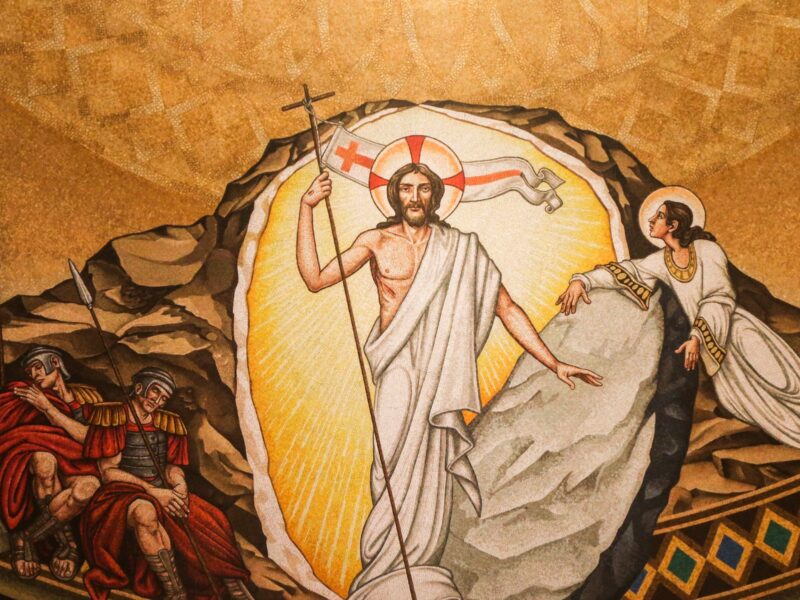
Set in Love
Third Sunday of Easter. Fr Dermot Morrin reflects on how the life of St Peter can help each of us to see how we are called to bear the imprint of Christ.
What happens to Simon Peter in today’s gospel looks like a step up. And to be honest, it is, Christ has set Peter up.
What transpires by the sea of Tiberias in the light of dawn is no accident. They have gone fishing at night on the lake, “but that night they caught nothing”. St Luke tells us that on the day Simon Peter first met Jesus, after a night when they caught nothing, he was told to throw out his nets again and they landed a massive haul of fish. There and then, Peter fell down before him saying: ”Depart from me, for I am a sinful man, O Lord.” (Lk 5:4-10).
As they land the fish, they see a charcoal fire and on it, are fish and bread. Not so long before in the court of the high priest Peter had been warming himself at another charcoal fire and it was then that he denied Christ not once but three times and heard the cock crow (Jn 18:27) St Peter is usually shown with keys in his hand, but in ancient days he was sometimes depicted with a cockerel. At the same time the fish and the bread must have brought to mind other days by that same sea, when everyone was fed and nobody was left hungry.
St Peter’s Basilica in Rome is built over the graveyard where it is thought that Peter was buried. The tradition is that Peter died in Rome as a martyr under Nero in a stadium on the Vatican hill, that he was crucified upside down and buried in a nearby graveyard. There are references in writers such as Tacitus to his tomb being a place of pilgrimage. In our time sections of that ancient graveyard have been excavated and directly under the main altar there is in fact a tomb with Peter mentioned in the graffiti on its walls. When they opened that grave they didn’t find his bones. They found a mixture of bones. But nearby they found the bones of a first century man, who might have been about 60 or 70 when he died. The bones show evidence of arthritis.
I was fortunate enough to visit the tomb as a student, but after about 10 years of priestly ministry I paid a second visit. I had lived in Rome as a student but in those days I was never a pilgrim. Now despite myself I became one. Quite a lot had happened in my life between those two visits. I had baptized so many children, and adults, rejoiced with newly wed couples, danced badly at birthday parties, worked in catholic schools, filled out school references, anointed the sick and the dying, buried the dead, listened to hopes and fears, the sorrows and the joys of countless people. Sometimes rightly and sometimes wrongly, they told me off. Sometimes I felt like a sponge for their anger or frustration. Sometimes I felt used, but other times I felt privileged, honoured and loved. Directly below the massive dome of St Peter’s, I saw again on the wall of his tomb the short prayers that pilgrims had scratched there: “Pray for me Peter”. Only then did I know the breadth, depth and colour of those prayers. The mist had become rain in dry and ancient dust. In a little niche in the wall, enclosed in glass, were some small fragments of the bones, relics of a seventy-year-old man with arthritis who had been a fisherman, and who had ended up dying such a cruel and painful death far away from his family. I though of Peter, the saint, who long after that first day by the shore of the sea, had grown old and had stretched out his hands, to be bound and taken somewhere he would rather not go. Those ancient bones reminded me of so many faithful people, I have had the joy of knowing. Peter knew failure and what it is to fish all night and catch nothing. He knew the smell of the charcoal fire. He knew in his bones that his strength was in Christ alone. He knew what it was to be marked with the sign of faith.
And so if this scene in the gospel is a set up, it is a set up in love. Christ says to him three times, “Do you love me?” And then and only then, “Follow me”.
…..remember the time
Before the wax hardened,
When everyone was like a seal.
Each of us bears the imprint
Of a friend met along the way;
In each the trace of each.1
May we who are what we become, be graced by the trace of his love in our hearts.
1 Primo Levi, “To my friends”, translated by Ruth Feldman and Brian Swann in Collected Poems, faber and faber 1992.


